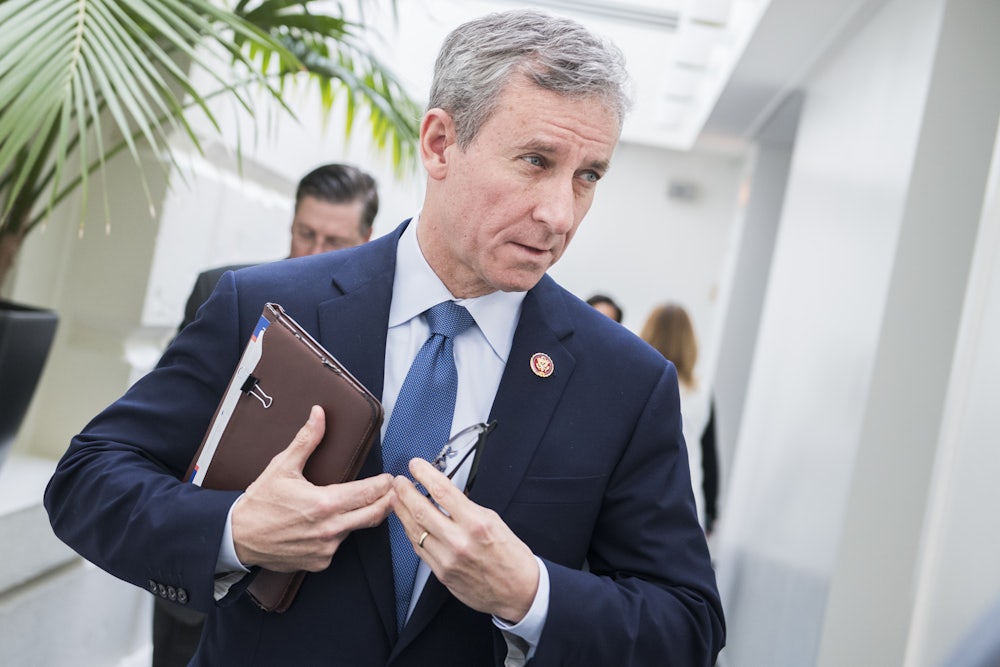Last December, Representative Abigail Spanberger won an important election within the Democratic caucus. House Democrats in competitive seats voted 37–20 to make her “battleground leadership representative”—a new role designed to steer Democratic strategy in competitive districts. And Spanberger, at first blush, appears well suited for the role, having ended a 36-year GOP hold on her seat in 2018 and then going on to win reelection twice, in a district Hillary Clinton lost by over six points and Joe Biden won by just one.
Her supporters in the caucus argued that her moderate positions and willingness to stick it to the progressive wing of the party on issues like defunding the police make her ideal for the post. And her vocal concerns over the party’s popularity, especially among working-class voters, are not unfounded. The problem is, there’s little evidence that she knows how to reach them.
Spanberger’s 7th district of Virginia, while certainly a battleground seat, is hardly an economically embattled region. Encompassing much of the Richmond metropolitan area, with rural counties running north toward Washington, the 7th district has a median household income of roughly $102,000, making it richer than 92 percent of all congressional districts. In addition, 38 percent of adults in VA-7 hold at least a bachelor’s degree, making Spanberger’s district among the highest-educated in the country. Spanberger’s success may be owed more to the fact that the 7th district is now home to many highly educated professionals than to her appeal to working-class voters. She carried the Richmond suburbs, while her GOP opponent took all eight of the 7th’s smaller, more rural counties.
That’s a problem, because those working-class voters are exactly the constituency Democrats have increasingly struggled to mobilize as the party has instead catered to the well-educated and well-heeled. Of course, it’s true that there are few Democrats who have proven capable of winning that elusive demographic. But one of them actually ran against Spanberger for the battleground leadership post. His name is Matt Cartwright.
Cartwright represents Pennsylvania’s 8th (formerly 17th) district, which encompasses the deindustrialized hubs of Scranton and Wilkes-Barre. The district swung for Trump by 10 points in 2016 and four points in 2020. Its median income is about $63,000, below the national median, and only 28 percent of Cartwright’s constituents hold a bachelor’s degree, with a significant share still working in manufacturing.
Beltway conventional wisdom would have us believe that a candidate like Cartwright couldn’t win unless he sounded as much like a Republican as possible. But Cartwright doesn’t sound like a Republican at all. He ran on fighting inflation by investing in local manufacturing and expanding Medicare. He backed ambitious infrastructure proposals, far-reaching spending on education, reforms to reduce drug prices, and public health–based solutions to the opioid crisis. Railing against corporate greed and price gouging has been central to his campaign strategy. And he’s co-sponsored legislation to expand Social Security.
So what’s the secret to Cartwright’s success, and can his winning formula be deployed elsewhere? A new study that we helped author from the Center for Working Class Politics sought to answer these questions. What we found was that, for Democrats to have any hope of winning a lasting majority, they need more Cartwrights.
To suss out what messages and policy platforms are most successful with working-class voters, we developed an experiment that generated thousands of hypothetical congressional candidates, with varying backgrounds and political positions, and had voters report which ones they preferred in head-to-head matchups.
We were particularly interested in the effect of political messaging around economic issues. To get at this, we provided each hypothetical candidate with one policy platform on an issue that is generally considered economic and another on an issue that tends to be viewed as social or cultural. Since candidate platforms also consist largely of non-policy-specific ideological appeals, each candidate was also assigned one of several sound bites, each of which mimicked some style of messaging that’s common in U.S. politics. Finally, some respondents were also shown a right-wing counter-message, so that we could assess how support for all the above changes in the face of various opposition talking points.
While the results provide a wealth of insights for progressive politicians seeking to compete more effectively among working-class voters, three in particular stand out.
First, regardless of their partisan allegiance, working-class voters respond positively to candidates who focus on jobs, including those who run on an expansive policy to provide a federal jobs guarantee. Jobs-focused candidates were particularly effective when they combined this policy platform with anti-elite, populist messaging that calls out the wealthy for rigging the system against working Americans. This combative, economic-populist messaging was particularly effective among key groups that Democrats struggle with most: manual workers, rural voters, and low-engagement voters.
Second, our survey also found that working-class voters respond most favorably to candidates from similar class backgrounds, and least favorably to candidates who come from an elite educational or economic background. In other words, working-class voters want working-class candidates.
Finally, the right-wing messages that we tested did not undermine the appeal of jobs-focused campaigns, economic-populist language, or non-elite, working-class candidates. In fact, our study suggests that running on a progressive jobs policy actually grows more effective in the face of certain opposition messaging. (Voters appear to see through some Republican attempts to pivot from their issues.)
This is all probably unsurprising to someone like Matt Cartwright, who by all appearances has been taking these dynamics for granted. In the 2022 midterms, only 18 percent of swing-seat Dems even mentioned jobs in their TV ads, and Cartwright was among them. His campaign put jobs front and center, emphasizing the need to invest in domestic manufacturing and transport infrastructure. He pitted workers against corporate greed—successfully casting his opponent in the latter role—and touted his record trying to expand Social Security. Spanberger’s ads, while they allude to general economic difficulties, do not frame them in such terms; on the contrary, one of them advertises a Chamber of Commerce endorsement.
The Democrats need more Matt Cartwrights, for two main reasons. First, Democrats cannot win a Senate majority without consistently winning in states where non–college educated workers are the overwhelming majority. In 2024, for example, Democrats will be defending vulnerable incumbents in West Virginia, Ohio, and Nevada (among others), where these workers make up 76, 69, and 72 percent of adults. Compare those numbers to the national average of 54 percent, and the urgency of reaching non-college workers is suddenly thrown into stark relief.
Second, while it’s true that the majority of Americans live in urban or suburban congressional districts, where levels of liberalism, education, and income are higher, the majority of districts themselves are not so. Only 43 percent of congressional districts have a median household income above the national median. And in 90 percent of districts, a majority of adults do not have a bachelor’s degree; among competitive congressional districts, that number rises to 92 percent. A strategy that prioritizes high-income and highly educated districts will inevitably make Democrats a minoritarian party.
The case for more Cartwrights, then, is just this: His unique combination of populist messaging and progressive economic policy aimed at working people can win because in electoral terms, much of America resembles his district. Cartwright’s success comes down to his ability to convince blue-collar Democrats to stay in the tent. Democrats need to make a choice going forward: Focus on working-class voters and work toward building a solid majority, or continue to squeak by—and risk government by an ever more dangerous opposition.






